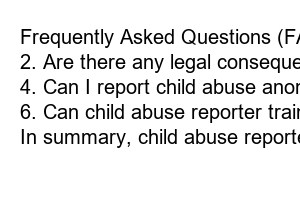아동학대 신고의무자 교육
Title: Child Abuse Reporter Training: Equipping Protectors for a Safer Future
Introduction:
Child abuse is a horrific crime that leaves scars on its victims that can last a lifetime. As responsible members of society, it is our duty to protect children from such abuse and provide them with a safe environment in which they can thrive. Recognizing the importance of reporting child abuse and ensuring the well-being of our young ones, child abuse reporter training programs have emerged as a vital tool in the fight against this menace. Let’s delve into how these training programs equip individuals with the necessary skills to become effective advocates for child safety.
1. Understanding the Dynamics of Child Abuse:
Child abuse reporter training starts with a comprehensive introduction to the various types of child abuse, including physical, emotional, sexual, and neglect. Through interactive sessions and real-life case studies, trainees gain the knowledge needed to identify signs of abuse and understand the intricacies involved.
2. Reporting Protocols and Legal Obligations:
Participants in these training programs learn about their legal obligations as mandated reporters, understanding the importance of timely reporting and the appropriate channels to follow. They familiarize themselves with reporting protocols based on local laws and guidelines to ensure that the information they provide is accurate and reliable.
3. Interviewing Techniques for Effective Documentation:
Thorough documentation is crucial when reporting child abuse cases, as it plays a pivotal role in subsequent investigations. Trainees learn interviewing techniques that allow them to effectively gather essential information while maintaining a safe and supportive environment for the child.
4. Trauma-Informed Approach:
Recognizing the impact of trauma on child victims, these training programs emphasize a trauma-informed approach. Participants learn how to interact sensitively with children, understanding the importance of empathy, active listening, and child-friendly language when seeking disclosure. By establishing trust, they facilitate the healing process for these vulnerable individuals.
5. Collaborative Efforts and Multi-Agency Cooperation:
Child abuse reporter training also underscores the significance of collaboration in the pursuit of child safety. By forging connections with other professionals, such as law enforcement officers, social workers, and medical personnel, trainees gain an understanding of the roles and responsibilities of each agency in addressing and preventing child abuse.
6. Self-Care for Child Abuse Reporters:
Reporting child abuse can be emotionally taxing, and training programs acknowledge the importance of self-care for those involved. Trainees are educated on the potential impact of vicarious trauma and are provided with strategies to cope with stress, ensuring their well-being and ability to continue advocating for children’s rights.
Frequently Asked Questions (FAQs):
1. What should I do if I suspect child abuse but am unsure?
2. Are there any legal consequences for failing to report child abuse?
3. How confidential is the information provided during reporting?
4. Can I report child abuse anonymously?
5. Are there any resources available for ongoing support after the training?
6. Can child abuse reporter training be done online?
In summary, child abuse reporter training programs equip individuals with the knowledge, skills, and resources needed to become effective advocates for child safety. By understanding the dynamics of child abuse, reporting protocols, trauma-informed approaches, and the importance of collaboration, trainees become empowered protectors of our children’s well-being. Through ongoing professional development and self-care practices, these dedicated individuals ensure the safety and security of our youngest and most vulnerable community members.

